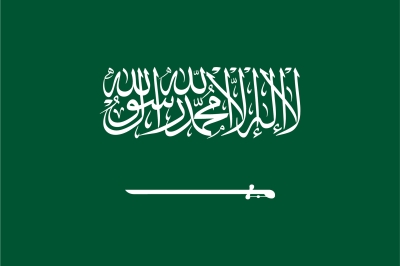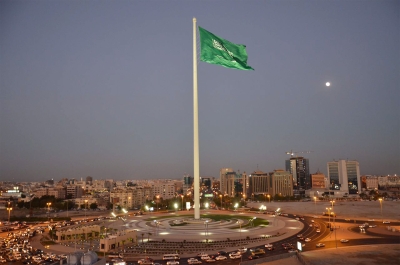

The National Symbols of the Kingdom of Saudi Arabia are visual or verbal representations or symbols of the characteristics of Saudi culture or Arab culture. Some hold official symbol status, being certified, approved, and regulated by the Royal Court, complete with enacted principles and guidelines. Examples include the Saudi national flag, the Saudi flag of His Majesty the King, and the official Saudi emblem. These symbols serve as focal points for media attention during national celebrations. While some national symbols lack a formal framework, they are recognized as equal to official symbols in importance both on a national and international scale.
Official Saudi emblem
The design of the official Saudi emblem consists of two crossed Arab swords topped with a palm tree in the center of the intersecting space they form. It symbolizes that prosperity is inevitable when justice is established.
The Saudi emblem shares the symbolism of the two crossed swords with the second design of the Saudi flag during the reign of the founder King Abdulaziz Al Saud.
The Saudi emblem was designed to encompass the characteristics of Saudi culture and is represented on top of original national documents, national identity cards, and currency notes. Its symbolic presence also appears in the identity designs of approximately fifty-eight governmental and ministerial entities in the Kingdom. Utilizing the Saudi emblem on commodities, products, and personal gifts is strictly forbidden.

Sword significance in the national symbols of the Kingdom
The traditional Arab sword has been a symbol of justice, strength, and sovereignty in Saudi culture for centuries. It stands as a cultural witness to the tales of the victories of the First Saudi State under the leadership of the founding Imam Mohammad Bin Saud, and the Second Saudi State under the leadership of Imam Turki Bin Abdullah Al Saud, whose sword was known as al-Ajrab.
The sword is also considered one of the most changed symbols on the Saudi flag in terms of design. It first appeared crossed with its counterpart in the second design of the Saudi flag during the reign of King Abdulaziz Al Saud. Through the several stages of the design of the Saudi flag, the shape and orientation of the sword changed until its latest form, positioned beneath the Shahada, was adopted. The sword also represents an essential part of the Saudi Ardah, the most important traditional dance in the Kingdom.
Palm tree significance in the national symbols of the Kingdom
In the Arabian Peninsula, the palm tree symbolizes Arabian abundance, growth, and vitality. It is mentioned approximately twenty times in the Quran, surpassing the mentions of other trees in the Quran. The palm tree is a mental symbol representing the identity of agricultural lands in the Kingdom and stands as one of the resources relied upon by Saudis for hospitality and leisure. The palm tree icon takes up the largest space in the design of the official Saudi emblem. It appears in most official designs in green, except for its golden color in the emblem of the Saudi flag of His Majesty the King.
Related quizzes

